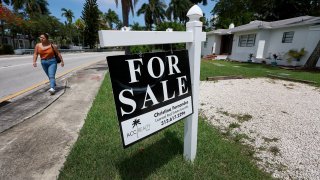
A ‘for sale’ sign hangs in front of a home on June 21, 2022 in Miami, Florida. According to the National Association of Realtors, sales of existing homes dropped 3.4% to a seasonally adjusted annualized rate of 5.41 million units. Sales were 8.6% lower than in May 2021. As existing-home sales declined, the median price of a house sold in May was $407,600, an increase of 14.8% from May 2021.
The Covid-19 pandemic caused chaos in the U.S. housing market, with prices skyrocketing, inventories dwindling and intense bidding wars.
Then came record inflation, which drove the price of everything higher.
The U.S. Federal Reserve, though, is waging an intense fight against rising prices, using interest rates as its primary weapon.
A side effect of raising interest rates, though, is higher mortgage rates.
Get Southern California news, weather forecasts and entertainment stories to your inbox. Sign up for NBC LA newsletters.
What's more, the Fed now owns $2.7 trillion of mortgage bonds, part of its plan to prop up the financial system when Covid first started. And it began selling them in June.
So what does the Fed's fight against inflation mean for the red-hot housing market? Watch the video above to find out more about how the Fed's interest rate tools affect the housing market, and how the Fed plans to unload the trillions of dollars worth of mortgage debt on its balance sheet.